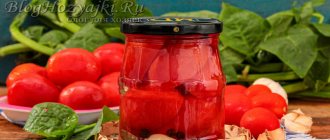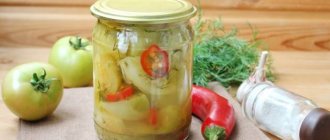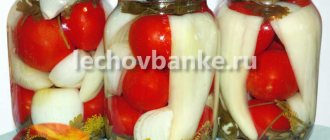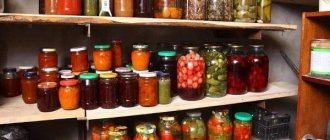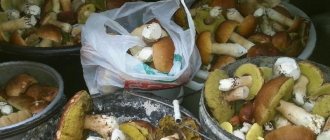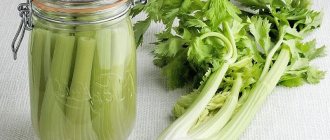Shelf life of canned tomatoes
- Shelf life: 12 months
- Shelf life: 24 months
- Shelf life in the refrigerator: 1 month
- Freezer life: not specified
Canned foods occupy a special place in our diet.
People always, after harvesting in the fall, canned vegetables, berries and other foodstuffs and filled the cellar with glass jars. And almost all of this was eaten over the winter. Nowadays, this has become easier, because everything is canned, and you can buy fresh in any supermarket. Although modern families are moving away from this, most families still stock up on supplies, since their homemade canned food is both healthier and tastier. It is no secret that all reserves of canned food are now replenished not from cellars, but from store shelves.
Most vegetables and berries lose their nutrients during canning, because exposure to high temperatures to kill bacteria also destroys beneficial substances. But tomatoes are not such vegetables and retain their beneficial properties and nutritional value.
How to choose canned tomatoes in the store
For those who buy canned vegetables, you need to know that the law “more expensive means better quality” does not apply here. How to choose salted tomatoes in the store. There are various cans on the shelves with a wide range of prices, and it is not clear which product is better among them. The first thing you should pay attention to is the brine. If it is cloudy, then it is better to put this jar aside. Also, the lid of the jar should not be swollen; if so, then the expiration date has already passed, or the preservation went wrong somehow. The next thing you should pay attention to is the fruits themselves; they should not be cracked. The more cracks, the lower quality the tomatoes.
As a rule, both home-canned and homemade tomatoes have the same shelf life. The shelf life of canned tomatoes is from 1 to 2 years.
Shelf life
Remember that any products have their own shelf life. They are most delicious when fresh, so you shouldn’t do a lot of preservation. You should estimate roughly how much inventory you need. You should not store jars with sealed salads or jam for several years. Over time, the process of oxidation and fermentation begins in the containers. At best, you will simply throw away the food, and at worst, you may get poisoned.
Prepare canned food for one season only.
How long does an open can of tomatoes last?
An open can of salted tomatoes will not last long. You can eat them until mold appears on the surface of the brine. In a warm place it appears much earlier and the shelf life of opened tomatoes at room temperature is no more than a week. In the refrigerator, such a jar can last from 2 to 3 weeks.
As a rule, both home-canned and homemade tomatoes have the same shelf life. The shelf life of canned tomatoes is from 1 to 2 years.
How long can you store an open jar of pickled tomatoes?
If you don’t get into this jar with your hands or dirty cutlery, then such a jar can last a very long time, I think, up to half a year. Because vinegar is an excellent preservative, especially since tomatoes contain acid. Together with vinegar, tomatoes don’t care even for long periods of open storage.
An open jar of pickled tomatoes can be stored at home at room temperature for 2 days , only if the jar is in a cool place on the floor, away from heating appliances.
For 2 weeks, an open can of tomatoes will retain its taste in the refrigerator and will not spoil, of course, if your tomatoes were rolled with the addition of vinegar.
If aspirin is added when rolling a tomato, then the shelf life is reduced.
If you opened tomatoes and stored them in a room, then of course they need to be consumed within today and, at most, tomorrow, it all depends on the temperature in the room. If stored in the refrigerator, the time will naturally increase. It’s impossible to say the exact number of days, since it varies from person to person; it rather depends on the recipe you used during pickling. I’ll tell you how I determine when you need to eat tomatoes urgently and when to throw them away. If a film begins to appear on the top of the brine, then the tomatoes should be consumed immediately, and it is advisable not to use the brine at all. If you haven’t noticed, and the film has turned white and covered the entire surface of the brine, some tomatoes are washed and eaten, I’m afraid and pour everything out - both the tomatoes and the brine.
If you don’t get into this jar with your hands or dirty cutlery, then such a jar can last a very long time, I think, up to half a year. Because vinegar is an excellent preservative, especially since tomatoes contain acid. Together with vinegar, tomatoes don’t care even for long periods of open storage.
How long can pickled cucumbers and tomatoes be stored?
How many years can jars of pickled cucumbers and pickled tomatoes be stored?
How long does it take for jars of pickles to go bad?
If you buy products in a store, the expiration date will be indicated on the packaging. But many people make the blanks themselves, so it’s not easy to define it. It is also worth noting that there is a shelf life, and there is an expiration date. The shelf life is the time within which it is preferable to consume the product, and after the expiration date the product cannot be consumed and can be considered spoiled. What is the shelf life of canned tomatoes? What is the shelf life of canned tomatoes? The first is 12 months if the workpiece is in proper conditions. The second is 1 year. After opening, a can of tomatoes can be stored in the refrigerator for 3-4 weeks, at room temperature for 1 week. What is the shelf life and shelf life of canned cucumbers? They last longer than tomatoes. The shelf life is 3 years and the shelf life is 2 years.
How many years can jars of pickled cucumbers and pickled tomatoes be stored?
Balcony
The modest size of the apartments forces residents to use every corner for business. Therefore, very often residents store preserved food on the balcony. Even small loggias can accommodate a lot of cans if the space is properly organized. It is best to install a cabinet or rack with doors so that sunlight does not enter inside.
You cannot store jars on an uninsulated balcony, so you will have to equip it well. Ideally, the loggia should have a heating device that can be used to maintain optimal temperature conditions. But pickles will have to be stored in the refrigerator if we are talking about sauerkraut.
Rare shot: Viktoria Isakova showed her grown-up daughter from Yuri Moroz (new photo)
“We are still friends”: Derevianko commented on the breakup with his wife
Women's jeans: before you buy them, you need to pay attention to one detail
In general, balconies are good for sealing, but only after some thermal insulation has been carried out.
General storage recommendations
It is important to store homemade mushrooms in glass jars correctly, since the harvested products have direct contact with the soil, and one should not fully rely on proper sterilization. If the storage regimes and terms are not observed, putrefactive bacteria and the botulinum virus, which releases a deadly poison - botulinum toxin, can multiply in the canned product.
We recommend reading: How Long Can Freshly Squeezed Pumpkin Juice Be Stored?
Note! When the botulinum virus multiplies, the appearance and taste of the preserved food does not change in any way.
Where and how to store homemade preparations
For each type of homemade product, it is necessary to maintain a special temperature regime and ensure correct storage conditions. At what temperature the preserved food should be stored depends on the technology of its manufacture:
- Products subjected to canning, i.e. hermetically sealed after heat treatment, can be stored at a temperature not exceeding 20 ° C and a humidity not exceeding 75%.
- Pickled, salted and soaked fruits should be stored at a temperature of 0 to 4 °C.
- For forest and garden gifts (mushrooms, berries, fruits), homemade canned meat and dairy products, the optimal temperature background is 3-8 °C.
- It is unacceptable to store glass jars at sub-zero temperatures. Freezing the contents is fraught with physical bombing that occurs due to the expansion of the liquid. Needless to say, the fruits will lose their appearance and their texture will deteriorate?
Do not consume the contents of cans that have been physically bombed. The freezing point of the brine is low to suppress the development of microflora that has penetrated through the deformed lid.
Based on these recommendations, you can independently choose a place to store the workpieces. Typically, cellars, basements, and garages are used for these purposes, but in an apartment you can also find a secluded corner for your culinary masterpieces.
Shelf life of pickled mushrooms
Let's consider the shelf life of homemade mushrooms under different storage conditions for containers with products, lids used and preservation methods.
Without refrigerator
Mushrooms canned in glass jars under plastic lids are stored without refrigeration for no more than 1 month, under metal and glass lids - no more than 3 months. The place where containers are stored can be mezzanines, pantries, or the space under the windowsill.
The air temperature should not be higher than 25 degrees. The optimal temperature range for storing mushrooms without a refrigerator is 15-18 degrees. It is important that the sun's rays do not fall on the product, as they contribute to the destruction of organic matter.
In a refrigerator
The best conditions for storing canned mushrooms are in the refrigerator or cellar. In this case, the optimal temperature range for preserving nutrients is 0-4 degrees. The shelf life of the blanks in this case depends on the type of lid:
- preservation under polyethylene covers – 6 months;
- under metal covers – 1 year;
- under glass covers – 2 years.
When metal lids come into contact with a solution of salt, sugar and vinegar, they begin to oxidize. If you are not sure that the tin lid reliably resists oxidative processes, do not store such a jar in the refrigerator for more than 3-4 months.
In the freezer
Since the marinade salt solution does not freeze, canned mushrooms can be stored in the freezer of a home refrigerator. Tubular mushroom organisms are better stored in this way, as opposed to lamellar ones, which, after thawing, can lose their elasticity and become too soft. The shelf life of mushrooms in the freezer is 2 years.
After opening the lid
After opening, preserved products under iron and other types of lids are stored in the refrigerator for no more than one day. To feed a small number of people, choose small jars so that the product can be consumed in 1-2 doses. For harvesting tasty forest creatures, containers with a volume of 0.7-1.0 liters are best suited.
Apartment
It is much more difficult to maintain conservation in an apartment. There are no cellars in high-rise buildings. Therefore, you will have to be content with balconies, storage rooms and loggias. In a heated room it is generally difficult to find a suitable place. And in an unheated one, you can’t keep jars.
Sometimes owners install miniature cabinets under the window sills in the kitchen. But this is only possible if there are no radiators nearby. The most popular storage place among apartment dwellers is the pantry. Sunlight does not enter it. In addition, it is removed from heat sources.
If your apartment does not have one, you will have to arrange a built-in closet yourself. It must be well strengthened so that the jars do not break. If you choose a location away from sunlight, doors will not be needed. Otherwise they will have to be made.
Why French children behave well: eight ways to raise them
A Brazilian travels 36 km by bike every day to take his loved one home.
Lost weight: what Sofia Tarasova sacrificed for the sake of “VIA Gra” (new photos)
When choosing a place for a pantry, remember that not only light is harmful, but also high temperatures. Some people hide jars behind cabinets, on mezzanines, behind sofas. In general, you can choose any room that does not have a high level of humidity. If at the entrance to the apartment you have two doors, between which there is a small vestibule, it can be used effectively. The temperature in the hallway is lower than in other rooms. The sunset will be safe there.
Why is mushroom overstay dangerous?
During long-term storage, especially at temperatures above 20 degrees, bacteria and viruses can begin to multiply intensively in jars with preparations, causing poisoning of the body - from banal diarrhea and vomiting to convulsions and loss of consciousness. The first signs of poisoning occur between 2 and 12 hours after ingestion of the product. If this happens, you need to immediately call an ambulance.
Other unpleasant consequences of storing mushrooms for too long are the oxidation of metal lids with the development of rust, and the growth of mold inside the jar. Such preparations cannot be eaten.
Storage locations
Different types of workpieces must be stored at a certain temperature. Much depends on the cooking technology.
If the seaming is hermetically sealed and has undergone heat treatment, it should be stored at a temperature no higher than +20 degrees. The humidity level should not exceed 75%.
Pickled, pickled and salted foods are more capricious. They must be kept at a temperature of 0...+4 degrees.
Vegetables, mushrooms and fruits are well preserved at +3...+8 degrees. Remember that glass containers cannot be kept at sub-zero temperatures. Freezing leads to physical bombing. This product will have to be thrown away.
Where to store pickled mushrooms?
We have discussed in detail that the best conditions for storing pickled mushrooms are in the refrigerator or cellar, but you can also keep mushroom preparations for the winter in the space under the windowsill or food pantry. The main thing is compliance with the temperature regime and the specified storage periods.
Be careful when preparing mushrooms at home, do not take unfamiliar or unfamiliar specimens, do not collect them along highways, as these special products adsorb heavy metals from exhaust gases. Take care of yourself and your loved ones!
The best conditions for storing canned mushrooms are in the refrigerator or cellar. In this case, the optimal temperature range for preserving nutrients is 0-4 degrees. The shelf life of the blanks in this case depends on the type of lid:
Cellar
A cellar is ideal for storing all types of preserves. But only owners of private houses or summer cottages can boast of its presence. Cellars are convenient because they maintain optimal temperature conditions and the correct level of humidity. In addition, in such rooms there is no sunlight at all, which is also very important.
If there is little snow, there will be no harvest: December 16 is Ivan the Silent Day
"Dad is offended." Agata Muceniece about her relationship with Priluchny after the divorce
A student at the Vietnam Police Academy shared how she takes care of her facial skin.
The cellar must have normal ventilation. If there is a risk of food freezing, you will have to insulate it.
Excessive dampness can lead to mold and mildew on the walls. Such conditions are unacceptable. Therefore, the surfaces will have to be treated with a solution of bleach or copper sulfate. This simple method will preserve the integrity of pickles and vegetables, because microorganisms penetrate even under nylon covers.
How to roll cucumbers
The ideal choice for preservation would be cucumbers of the “Delicious”, “Graceful”, “Nezhinskie” varieties, as well as the “Rodnichok” variety and long-fruited cucumbers grown in open ground. To seal a jar of cucumbers for the winter, use the triple hot pour method.
Take a prepared three-liter jar, put washed parsley, mint, horseradish leaf, dill, celery and black currant leaf on its bottom - all 10-15 grams each. Place several cucumbers horizontally and vertically on top of the greens, and on the very top place a sprig of fresh dill with seeds (you can use fresh or one that has already dried out). Then pour boiling water into the middle of the jar so that its walls are evenly heated.
Freshly picked young, firm, bright green cucumbers are great for home canning.
Place the lid of the jar in boiling water and carefully remove it with tweezers. Cover the jar with a scalded lid and wait a few minutes, then drain the water from the jar into the pan and pour boiling water over the cucumbers again. Pour out the water and put 10 grams of horseradish and 3-5 cloves of garlic in a jar. Prepare the marinade by adding 35 grams of sugar and 90 grams of salt to the water from the first pour. Boil the marinade for several minutes and pour 100-150 grams of vinegar into it. Pour the hot marinade over the cucumbers a third time to the very top, seal the lid and turn the jar upside down, leaving it to cool.
We recommend reading: How long to store Apostupotatoes in the refrigerator
How long can canned cucumbers last?
There is a difference between the shelf life of home-canned and store-bought canned goods. Cucumbers purchased at the supermarket can be stored for three years, but if they contain little vinegar, the three-year period is reduced to two years. When buying store-bought cucumbers, compare the release date with the current date - it is better not to eat last year’s preserved cucumbers.
Never buy a bulging jar of canned cucumbers - they are extremely dangerous to your health.
It is advisable to use canned homemade cucumbers within a year, since during long-term storage they lose many useful substances and become less safe for the body. Home preserves can develop botulinum toxin, which causes poisoning, often leading to death.
How many people are sent pickled vegetables by grandmothers, aunties and relatives from villages? If you doubt the quality of the resulting preparation, boil the cucumbers for 10-15 minutes - all the toxic substances in them will be destroyed under the influence of high temperatures.
Take a prepared three-liter jar, put washed parsley, mint, horseradish leaf, dill, celery and black currant leaf on its bottom - all 10-15 grams each. Place several cucumbers horizontally and vertically on top of the greens, and on the very top place a sprig of fresh dill with seeds (you can use fresh or one that has already dried out). Then pour boiling water into the middle of the jar so that its walls are evenly heated.
How long can you store homemade pickled mushrooms?
For most people, mushrooms are a special tasty dish , and sometimes even a delicacy. Therefore, it seems that those who have the opportunity to independently collect and replenish their provisions with mushrooms are the lucky ones.
The mushroom harvest makes you happy and you want to prolong the taste of nature’s gift as long as possible, and for this you need to know how long to store the preparations at home.
A mushroom is a special organism that does not form flowers or seeds and reproduces by spores. Various scientific sources call a mushroom an organism, a plant or a vegetable. But, by and large, two criteria are important to us: taste and benefit. Let's talk about the edible properties and how to store homemade pickled mushrooms.
Video tips for setting up a balcony cellar
Balcony cabinet updates:
Insulated and spacious wardrobe:
Review of a homemade heating cabinet:
As you can see, even in a city apartment you can find a suitable place to store numerous pieces and twists that you have prepared yourself. It remains to decide which design is more suitable for your balcony, because the choice is really wide: from stylish custom-made cabinet models to convenient, self-made storage boxes and shelves.
At home, canning, pickling and pickling help preserve vegetables, mushrooms and fruits for a long time. In the article you will find information on how to properly store preparations in the winter in apartment conditions, on the balcony and in the cellar, what conditions are optimal for saving. You will also learn why delay is dangerous, how to recognize it, and what the shelf life of various types of homemade products is.
Healing properties of mushrooms
There is no doubt that this is a nutritious and satisfying product. Very tasty with potatoes and sour cream, in salads and especially good as an appetizer. Did you know about the healing properties of the product and that there is a method of treatment with mushrooms - fungotherapy.
Research has shown that everyone's favorite whites are champions of healthy proteins and contain vitamins to strengthen the cardiovascular system. Boletus also has the “heart” vitamin PP. Of all the familiar mushrooms, it especially stands out for its commendable taste and appearance.
The fleshy, dense breast is a natural source of “sunshine” vitamin D, has diuretic properties, and is therefore a good remedy for preventing the formation of kidney stones.
Chanterelles contain a lot of zinc, selenium, vitamins A, B1, B2 and are therefore called a fungal antibiotic that removes radionuclides from the body. Chanterelles are considered high-quality mushrooms due to their gastronomic properties. Low-calorie, tasty and healthy combination!
Types of homemade preparations
Now a few words about the types of preparation for future use and in more detail about the storage conditions for mushrooms. Experienced mushroom pickers know several ways to stockpile mushrooms:
- salting;
- drying;
- freezing;
- pickling;
- pickling;
- canning.
The most popular methods of storing mushrooms at home are pickling, canning and drying mushrooms.
It is recommended to store dried ones in sterilized jars with metal or plastic lids so that they do not absorb moisture and odors. In a dark and dry place, such mushrooms can be stored for up to 2 years.
In this case, they retain their aroma and taste. But still, it is better to store dried ones for no more than one year. The more time passes, the less protein and nutrients remain in them. Experienced mushroom pickers store only until the new season.
Where is it not recommended to keep preserves?
Not suitable for storing jars with blanks:
- Toilet . This is a controversial statement and a question for everyone. Some people think that canned food from the toilet is unhygienic. Others, without disdain, store canned food on a shelf behind the cistern.
- Space near the trash can . Neighborhood with garbage also contradicts hygienic canons. If there is no other way out, then the cabinet where the garbage disposal is located can be divided into two parts using a board.
- Places near heating devices . Canned food is not a fan of “hot climates,” and the time and labor spent can be wasted, and the mood is spoiled by periodic “explosions” of lids and unsuitable products.
- Under the bathroom and other places with excessive moisture . This storage method can also lead to premature “death” of canned food.
- Children's room . Everything is clear here: the safety of the younger generation is paramount. Children, while fooling around and playing, can accidentally break “glasses” and get injured.
- Pet-friendly areas . Cute “fluffies” are creatures even more unpredictable than children. A beloved Labrador, for example, may view a jar of brightly colored tomatoes as an interesting toy. But such a game can lead to dire consequences.
- Hard to reach cabinets . Dropping the jar is the lesser of two evils in this case. You can injure yourself while getting it out, for example, by falling off a stepladder.
Fruits, berries, vegetables, lovingly packaged in jars, will decorate the winter menu and remind you of summer days. And even in a small-sized apartment, you can, by showing ingenuity and ingenuity, find them a worthy place in your home.
Shelf life of canned mushrooms
Mushrooms are an excellent dietary product, with a large amount of vitamins C, B, PP, potassium, iodine, and carbohydrates. Therefore, it is one of the favorite products for many. Fortunately, you can can them yourself or buy them ready-made.
If you bought it in a store, the expiration date will be indicated on the product label. The product must be marked according to GOST: type of mushrooms (whole or cut), method of preparation, storage temperature and expiration date . When purchasing canned mushrooms, pay attention to the quality of the liquid, i.e., the transparency of the marinade. It should be light, colorless or yellowish. Before purchasing, consider the contents of the jar; there should be no dark spots on the mushrooms.
We recommend reading: How long should soy sauce be stored in plastic jars?
Read the label carefully for how long canned mushrooms can be stored; this information must be indicated. Do not buy an expired product, it is dangerous!
Precautionary measures
Often, mushrooms that are prepared at home are much tastier, more aromatic and more varied in taste, but you need to know and maintain the shelf life of this tasty dish, otherwise the consequences can be serious.
Precautionary measures:
- collect only familiar mushrooms, whole, not overripe and not wormy;
- Before cooking, carefully inspect and re-sort;
- thoroughly clean from sand, soil, leaves;
- observe the norms for cooking duration and temperature;
- adhere to storage conditions and periods.
We hope that you are well aware of them and that you comply with them.
Fresh but unwashed mushrooms should be stored in a cool place at a temperature just above zero for only 1 day and no more than 9-11 hours at temperatures up to 10 degrees.
If you put them in the refrigerator, storage is permissible for up to 24 hours at temperatures up to 7 degrees.
Fresh mushrooms should be stored in open enamel containers. Aluminum or iron cookware is not suitable. But it's important to know that the sooner you cook them, the better.
Homemade pickled mushrooms
They are obtained by using marinades that contain salt, sugar, vinegar or citric acid, as well as various spices. The choice of spices depends on your taste preferences.
The marinade is poured with the familiar white mushrooms, honey mushrooms, boletus, russula, milk mushrooms, aspen mushrooms, boletus mushrooms, boletus mushrooms, etc. Fortunately, Mother Nature has endowed with a very diverse variety of species. The marinade gives the dish a fragrant aroma and taste!
Such homemade preparations are stored in glass jars, adapted containers or special food containers. To protect against oxygen entering the container and mold, many people use boiled oil.
If there is no cellar or cold pantry, housewives store pickled preparations in the refrigerator. The shelf life of the product under these conditions, at temperatures up to 10 degrees, is 7-9 months. Don’t forget to write the seaming date on the dish and check how long pickled mushrooms last in the refrigerator.
Be careful, botulinum
Pickled mushrooms at home are often sealed in glass jars with hermetically sealed iron lids. With this type of preservation, it is necessary to remember precautions to avoid dangerous poisoning by botulinus bacteria.
The microorganism, botulinus , lives in the soil and in natural conditions it is completely harmless, but when there is a lack of oxygen, it produces poison.
Hermetically sealed protein products - mushrooms and meat - are most susceptible to this poison. For this reason, it is necessary to strictly observe the temperature conditions for preparing food and the expiration dates for storing mushrooms at home.
City balcony – spare “refrigerator”
In a village or country house, there are no problems with storing jars of home preserves. Entire storage facilities are built in the ground floor; caissons are buried in the ground right next to the house or garden. Some owners wisely use summer kitchens, verandas, cold corridors and even attics. However, for the city, or more precisely, for residents of multi-storey buildings, all of the listed options are unacceptable, especially if they do not have their own garage. We have to find ways to store blanks in a city apartment.
The refrigerator is not intended for long-term storage of canned food
A storage place for pickled cucumbers and mushrooms, sauerkraut, and homemade stew must be found before you start preparing them. A loggia or balcony is perhaps the only area suitable for storing cans, containers and bags of tasty preparations for the winter. It remains to fulfill several conditions so that the products do not spoil and do not freeze with the onset of frost:
- install new, preferably double, double-glazed windows or repair old glazing if it does not provide the necessary microclimate;
- insulate the ceiling, floor and walls;
- install racks or cabinets with shelves for convenient storage;
- adjust lighting (including lighting in cabinets).
In this case, you need to make maximum use of the usable space, since it is limited and cannot accommodate a large number of shelving, unlike, for example, a village cellar.
Open shelves are convenient, but not the best in terms of proper storage
If everything works out with the installation of a balcony cellar, then you will be able to stock up on signature recipes every year, and on holidays please your household with delicious homemade preparations.
Sealed storage: conditions and terms
GOST defines how long pickled mushrooms can be stored under an iron lid.
In glass jars under metal lids, pickled mushroom products can be stored for up to 1 year. Over a year, the metal oxidizes and the product deteriorates.
Shelf life under glass lids is 2 years, since glass is more resistant to the influence of salty and acidic environments.
Canned products must be transferred to cool conditions, a cellar, balcony, refrigerator, where there is no access to a large amount of light. Inspect rolled cans periodically to spot possible mold growth in time.
If you notice a small film , you need to drain the marinade completely , wash the mushrooms and repeat the canning process in new fresh brine. Unfortunately, after repeated cooking, products partially lose their taste and beneficial properties. Therefore, it is so important to follow the rules for storing home preserves and the heat treatment time during initial preparation.
Marinated mushrooms in the refrigerator
So, let’s find out how long pickled mushrooms can be stored in the refrigerator and other cool places:
- up to 10 degrees without hermetically sealing the cans - 7-9 months;
- at 4-6 degrees in glass jars with iron lids - 1 year;
- at temperatures up to 5 degrees in jars with hermetically sealed glass lids for up to 2 years.
At temperatures below −15−18 degrees, mushrooms can be stored for up to 3−4 years. But in this case, the taste and beneficial properties are lost.
Advice from gastroenterologists
- In case of poisoning, consult a doctor immediately! Immediately rinse the stomach and give the patient cold, lightly salted water, tea, and milk. Alcohol is strictly prohibited.
- Children under 6 years old should not be given any mushrooms, as they can be harmful to the body.
Happy mushroom harvest to you! Be careful and healthy!
The marinade is poured with the familiar white mushrooms, honey mushrooms, boletus, russula, milk mushrooms, aspen mushrooms, boletus mushrooms, boletus mushrooms, etc. Fortunately, Mother Nature has endowed with a very diverse variety of species. The marinade gives the dish a fragrant aroma and taste!
Balcony furniture for conservation storage
The most successful way to save limited space is to use shelves, racks and cabinets for storing preserved food on the balcony. Let's consider options that are convenient to use and suitable for a harmonious interior arrangement.
Racks and shelves
Horizontal surfaces located at a convenient height are considered the most suitable place for placing numerous jars with winter preparations. They can take the form of open and closed shelves suspended from the walls, or racks that occupy all the free space.
Even one small shelf can accommodate a dozen cans
However, not every shelf is suitable, because jars filled with liquid and food have considerable weight. Therefore, conservation shelves on the balcony should have the following characteristics:
- durable, processed material;
- high-quality metal fasteners (plastic will not work);
- sufficient length and width;
- a suitable height for comfortable use (approximately from 0.6 m to 1.7 m).
It is better to select the maximum width so that 2-3 rows of cans can freely fit on the surface, but keep in mind: the larger the width of the shelf, the stronger the fastenings should be.
Where should the shelves be installed? On typical balconies, the entire front side is occupied by double-glazed windows, the back wall is occupied by a window and an entrance door, and two end walls remain. They are suitable for hanging shelves, provided that the wall is strong. Loggias with concrete and brick walls benefit. However, if, when insulating a balcony, you foresee the installation of shelves or built-in cabinets in advance, then with other options there will be no problems with creating a mini-warehouse.
Shelves made during thermal insulation and wood lath paneling
To save space, which is usually not enough, it is important to correctly consider the height of the shelves. Think about the types of jars you typically use and adjust the space between shelves to accommodate them. Don’t forget that a distance of 10-15 cm above the jars will allow you to quickly find the canned food you need and carefully move the containers apart to get what you need.
Simple ways to create a convenient pantry with shelves:
- process wooden boards yourself (chipboards, MDF, plywood are also suitable), put together shelves and hang them from the walls;
- buy a ready-made wooden or metal rack according to the size of the balcony;
- organize storage during the process of sheathing and insulation;
- make universal decorative shelves and, if necessary, use them to store workpieces.
Advice! Canned food should not be placed in the light, so for long-term storage of canned food, be sure to equip all shelves with doors.
Option for self-production - wooden shelves on a metal profile



